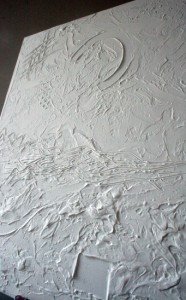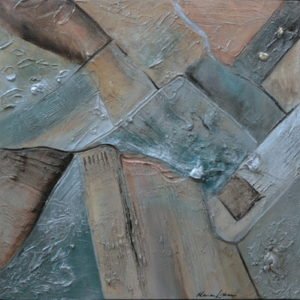Applying Paint to Texture

Once you have made your texture and have applied it to the canvas, it is advisable to leave the texture to dry overnight so that all of the thickest parts of the texture have dried out.
If you have created the texture using my texture recipe then you can apply this to the canvas really thickly and it will not reduce or shrink back too much. You can also just apply it to parts of the canvas or use masking tape to mask off areas for different patterns. Stencils can also work well to give a raised effect of a particular shape.
In some cases it might be necessary to leave the texture to dry for longer than 12 hours but this is really only if you have applied it extremely thickly. (I usually just leave it overnight).
Make Marks and Patterns
The more patterns and marks you make in the texture, the wider the variety of paint effects you can use to apply the paint on the texture.
Pick any household implements to use to make marks in the texture, like forks, spoons, sticks etc.If you stick masking tape to the canvas, you can use a craft knife to cut out patterns and this should not cut into the canvas.
Apply Many Coats
I can’t stress too much how much better the painting looks when you apply many layers of paint.
To start off with I always apply a watered down coat of a neutral colour to the textured base.
Use about 1 part paint to 1 part water and make sure that you cover the whole canvas and get into all the cracks in the texture. Let this initial coat dry before adding any further paint layers on.
When applying paint to texture, the paint has a different translucence than it does purely on the canvas and you can get more vibrant colour effects if all the texture is initially covered with paint.
One thing I recommend that you do before creating a painting with heavy texture is to create a trial piece on a small canvas, perhaps marked out into squares with different types of texture in each – perhaps some scraped marks, some added swirls, some deliberate cracks etc, then you can test out applying different thicknesses of paint.
Apply Paint in Different Ways
Try applying paint in different ways to the texture and in many layers. Some examples of ways of applying paint to texture are:
- Apply the paint straight from the tube/bottle(i.e. in its original consistency) but leave it for about 30 seconds before wiping some of it off with a cloth or tissue. This enables some of the paint below to show through.
- Use a very watered down version of the paint to create a glaze – this can be quite useful to apply over the top of your colour and will show in the cracks of the texture particularly if you use a dark colour. You can just do this in some areas where there is deeper texture or else apply it all over the painting. You can also rub some of this off with a dry or wet cloth to get different effects.
- Use some dry-brushing on the textured surface so that it only covers some of the higher texture. Make sure you really don’t have much paint on your brush and that the brush is completely dry before you use it. This is quite a good thing to do as a last layer and I often use white, silver or gold to do this.
 Use these techniques in lots of layers and it will enable you to build up a texture painting with different colours showing through. I can often apply between 6 and 10 coats of paint before I am happy with something. And don’t be afraid to keep going if you are not happy with what you have – you can just keep painting over it.
Use these techniques in lots of layers and it will enable you to build up a texture painting with different colours showing through. I can often apply between 6 and 10 coats of paint before I am happy with something. And don’t be afraid to keep going if you are not happy with what you have – you can just keep painting over it.What to Use to Apply the Paint

At the end of the day there is no right or wrong and you can use whatever you have available to try and create different effects on the surface.

ReneeJune 21, 2020 3:51 pm /
Hi I applied texture paste to my canvas and then i applied some acrylic paint. i put down some Saran Wrap and moved it all around to try and get some patterns in the paint. It did not show up at all. Is there a way to move around the paint with a plastic bag of some sort as I do on my smooth canvases? I also had a hard time spreading the paint. Is there a way to remove some of the dry texture and maybe put gesso on after removing some of it? I now gessoed over the whole thing thinking it would get rid of some of the texture but it didn’t. Any suggestions? Thank you.